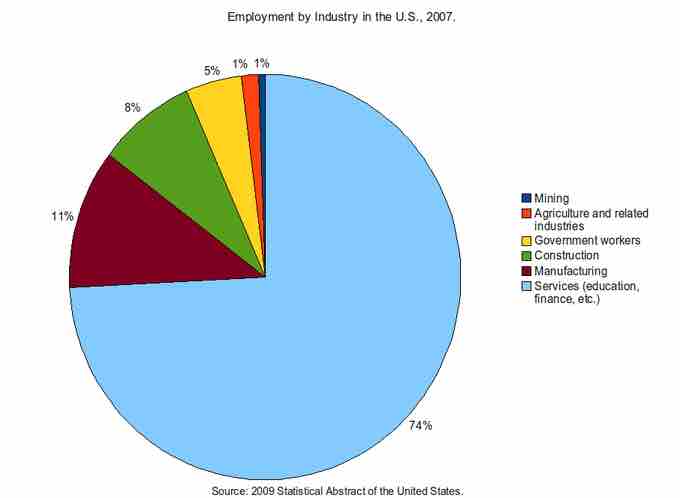The Four Social Revolutions
Most societies develop along a similar historical trajectory. Human groups begin as hunter-gatherers, after which they develop pastoralism and/or horticulturalism. After this, an agrarian society typically develops, followed finally by a period of industrialization (sometimes a service industry follows this final stage). Not all societies pass through every stage, and some societies remain at a particular stage for long periods of time, even while others become more complex. Still other societies may jump stages as a result of technological advancements from other societies .

The stages of societal development
The relationship between the stages of societal development (top row) and its implications (bottom row) are complex and interdependent.
Hunter-Gatherers
The hunter-gatherer way of life is based on the consumption of wild plants and wild animals. Consequently, hunter-gatherers are often mobile, and groups of hunter-gatherers tend to have fluid boundaries and compositions. Typically, in hunter-gatherer societies, men hunt wild animals while women gather fruits, nuts, roots, and other vegetation. Women also hunt smaller wild animals.
The majority of hunter-gatherer societies are nomadic. Because the wild resources of a particular region can be quickly depleted, it is difficult for hunter-gatherers to remain rooted in a place for long. Because of their subsistence system, these societies tend to have very low population densities.
Hunter-gatherer societies are characterized by non-hierarchical social structures, though this is not always the case. Given that hunter-gatherers tend to be nomadic, they generally cannot store surplus food. As a result, full-time leaders, bureaucrats, or artisans are almost never supported by hunter-gatherer societies. The egalitarianism in hunter-gatherer societies tends to extend to gender relations as well.
Pastoralism
In a pastoralist society, the primary means of subsistence are domesticated animals (livestock). Like hunter-gatherers, pastoralists are often nomadic, moving seasonally in search of fresh pastures and water for their animals. In a pastoralist society, there is an increased likelihood of surplus food, which, in turn, often results in greater population densities and the development of both social hierarchies and divisions of labor.
Pastoralist societies still exist. For example, in Australia, the vast, semi-arid interior of the country contains huge pastoral runs called sheep stations. These areas may be thousands of square kilometers in size. The number of livestock allowed in these areas is regulated in order to sustain the land and to ensure that livestock have enough access to food and water.
Horticulturalist Societies
In horticulturalist societies, the primary means of subsistence is the cultivation of crops using hand tools. Like pastoral societies, the cultivation of crops increases population densities and, as a result of food surpluses, allows for an even more complex division of labor. Horticulture differs from agriculture in that agriculture employs animals, machinery, or other non-human means to facilitate the cultivation of crops. Horticulture relies solely on human labor for crop cultivation. Horticultural societies were among the first to establish permanent places of residence. This was due to the fact they no longer had to search for food; rather, they cultivated their own.
Agrarian Societies
In agrarian societies, the primary means of subsistence is the cultivation of crops using a mixture of human and non-human means, like animals and machinery. In agriculture, through the cultivation of plants and the raising of domesticated animals, food, feed, fiber and other desired commodities are produced.
In comparison with the previously mentioned societal types, agriculture supports a much greater population density and allows for the accumulation of excess product. This excess product can either be sold for profit or used during winter months. Because in agricultural societies, farmers are able to feed large numbers of people whose daily activity has nothing to do with food production, a number of important developments occur. These include improved methods of food stores, labor specialization, advanced technology, hierarchical social structures, inequality, and standing armies.
Industrialization
In an industrial society, the primary means of subsistence is industry, which is a system of production based on the mechanized manufacture of goods. Like agrarian societies, industrial societies lead to even greater food surpluses, resulting in even more developed social hierarchies and an even more complex division of labor.
The industrial division of labor, one of the most notable characteristics of this societal type, in many cases leads to a restructuring of social relations. Whereas in pre-industrial societies, relationships would typically develop at one's place of worship, or through kinship and housing, in industrial societies, relationships and friendships can occur at work.
Post-Industrial
In a post-industrial society, the primary means of subsistence is derived from service-oriented work, as opposed to agriculture or industry. Importantly, the term post-industrial is still debated, in part because it is the current state of society. Generally, in social science, it is difficult to accurately name a phenomenon while it is occurring.
Most highly developed countries are now post-industrial. This means the majority of their workforce works in service-oriented industries, like finance, healthcare, education, or sales, rather than in industry or agriculture. This is the case in the United States .

Employment in the US according to industry, 2007
Less than 2% of the US population is employed in agriculture.